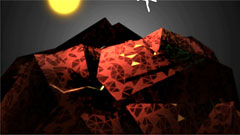Tony Comley talks about his latest film, ‘Verse.
 What interested you in creation myths and in crafting your own version?
What interested you in creation myths and in crafting your own version?
The sheer scale of creation myths next to the pettiness of their usual themes makes me very happy. Stories that anthropomorphise things like stars are so brilliantly vulgar that it’s hard not to admire them. For example one Australian Aboriginal myth has the Sun creating Man because she disapproves of marsupials.
I don’t believe for a second that the Universe was created, though I’d hesitate to label myself an Atheist for the same reason that I don’t declare myself an Acorianderist (I can’t bear Coriander. To me it’s like putting nail-polish on your tongue), so my interest in creation myths is more aesthetic than spiritual.
For ‘verse I took a loose, intuitive approach to writing and was surprised at how earnest it became. What began as a satire became a melodrama. The first draft had God creating Mankind purely because he knew it would result in helicopters. But by the time I arrived in Wales it had turned into a bitter-sweet comic riff on unrequited lust. Though that probably says more about my ability to relate to other human beings than it does about creation myths.
 How would you describe the animation techniques you used?
How would you describe the animation techniques you used?
Part of the joy of a creation myth is that it’s an open brief stylistically and by the time I settled on a visual identity I’d gone through stop-motion, live action, sock puppets and all kinds of things that look better on paper than they would on film.
The end product is a strict mix of hand drawn 2D and purposely simple 3D. I’m increasingly a fan of designers like Paul Rand and Keita Takahashi (responsible for Katamary Damacy, Nobi Nobi Boy and an impending kids playground in Nottingham). For me their work is the difference between minimal and concise. There’s an ostentation common to both, but they achieve it with very simple and direct forms.
The visuals for ‘verse were created in After Effects, which has about the same 3D modelling capabilities as Origami. I can’t deny that part of the motivation for using it was a complete lack of Maya expertise, but actually it made sense for the same reason people sometimes draw with charcoal instead of pencil. The 2D was created in Flash and kept to incidental flourishes like belching smoke or tears. I felt this balanced with the starkness of such polygonal 3D and reflected the creative spontaneity of the God character.
The voice-over was courtesy of the head of Performing Arts at the University. I went there with the intent of asking if he knew of any students who’d be game, but as soon as he spoke the hairs on my back stood up and I managed to rope him in to it. I’d recorded my own voice for the animatic, which lent the piece an unintentional comedy, so it was a relief to lay down some proper pipes.
The composer, Charlie Piper, is classically trained and though he’d never scored a film before, it paid off hugely. I think t he music he produced for ‘verse is enormously well judged. I described the film to him as being bookended by a waltz and so he worked in a beautiful swirling device at the beginning and end that colours the film simultaneously melancholic and absurd. He’s a genius that boy.
 How did the Animator in Residence gig come about?
How did the Animator in Residence gig come about?
Indirectly it’s had a huge effect. I was approached about A.I.R. while at the British Animation Awards (where I won a prize!). I went with Ian Gouldstone who’s a close friend and an alumnus of the scheme. He introduced me to someone from the Uni and we got chatting. I was there because of some documentary work that was commissioned after a director at Channel 4 saw Abigail on BBC Film Network, so I’ve a lot to thank for the attention that Abigail got. I’m not sure where Film Network saw it though (Maybe SOTW!)
Having gone through the A.I.R. scheme I’m a big fan. I think it’s well balanced in it’s current form. As you probably know, there was a similar scheme a while back that involved working inside a glass cage in a museum, but I can’t imagine that the sight of me slowly losing moisture in front of a Mac is particularly thrilling, so I was grateful for the privacy of a computer suite. The scheme is normally a month to make a 1 minute film, but I got cocky and made four minutes in three weeks. The production process therefore was a greatest hits of animation sexiness: Bloodshot lifeless eyes, Jaffa Cakes, breakdown of social skills, Facebook etc.
Thankfully the students grew to tolerate this and were great fun to direct. The whole thing takes place in a small and brilliant Roman town near the border called Caerleon. You do have to go through Newport to get there, but it’s worth it.
 Andrew S Allen
Andrew S Allen